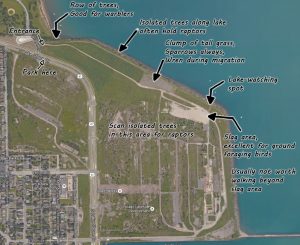Tag Archives: American Tree Sparrow
Rock Cut State Park
Rock Cut State Park is located northeast of Rockford. It is bisected by I-90. A convenient exit is located at the intersection of I-90 and IL 173. Proceed west from the exit ramp (toll at this spot-no cash, only IPass) to the main entrance off of IL 173.
The entry road will pass through a planted prairie and then into scrubby second growth. This area should be checked for Northern Shrikes in March and sometimes Loggerhead Shrikes in late March/early April. The shrikes are often in the vicinity of the campground. Turn left at the first stop sign and drive 500 feet to the campground entrance. The loop road is closed beyond the campground entry during the winter, but you can enter the campground. Once the roads are cleared of snow, the gates are often opened and the full loop road can be accessed. On the entry road into the campground, look for a variety of sparrow species, particularly Fox, Song, American Tree and juncos. n early Hermit Thrush might be in their company.
Once you check the campground, retrace your path back to the stop sign intersection on the loop road and turn left toward Pierce Lake. The road will pass through upland hardwood forest which is pretty empty of birds during winter, so keep going to the parking lot by the dam at the west end of Pierce Lake. The deepest part of the lake is just east of the dam. Check the open water on the lake. If the lake is open, there are several other spots to check for waterfowl, including the Red Oak picnic area. Continue on the loop road across the dam and follow it past the concession stand to the driveway to Red Oak. Park at the end of the lot up on the hill and walk down toward the lake for the best views.
The Olson Annex to Rock Cut SP is located on the east side of I-90. You can cross over I-90 on a small bridge from the main loop road and, at the stop sign, turn left toward the beach area. Olson Lake is much more shallow than Pierce Lake, and it freezes deeper, so it is later to open in the spring. Diving ducks are usually at the western end, near the dam/spillway, while the east end has puddle ducks.
Lake County Fairgrounds
Though discovered years before, 2012 has seen a rise in interest in the Lake County Fairgrounds as a birding destination. With close proximity to a dump, it is easy to see what makes this spot stand out in the winter months.
The fairgrounds main parking lot is becoming a good destination for winter gulling in Lake County and one of the only reliable Lake County spots outside of Winthrop Harbor that hosts a wide range of species in the winter. As per usual, the dominant species in the parking lot are Herring Gull and Ring-billed Gull. Scattered amongst these species, there have been records of Lesser Black-backed Gull, Thayer’s Gull, Iceland (Kumlien’s) Gull, and California Gull.
Just north of the parking lot is a small ponds that many of the gulls travel to for preening and water. This pond in April had a beautiful pair of juvenile Bonaparte’s Gulls that spent the better part of a week feeding there. Besides the gulls, this pond can hold significant amounts of waterfowl. Recorded so far have been, Canada Goose, Cackling Goose, Mallard, Northern Shoveler, Green-winged Teal, Blue-winged Teal, Northern Pintail, Hooded Merganser, Wood Duck, and American Wigeon.
In summer, the pond dried significantly, revealing decent mud flats. Large numbers of Great Egret and Great Blue Heron congregated in late summer and shorebirds seen during fall migration included Lesser Yellowlegs, Greater Yellowlegs, Least Sandpiper, Pectoral Sandpiper, and Spotted Sandpiper. Sora’s have been heard and seen in the cattails.
The gravel parking lot to the west of the pond had summering Horned Larks. In winter, flocks of American Tree Sparrow are common, and on rare occasions, Snow Bunting have been seen and heard. The fairgrounds is also an easy spot to pick up American Kestrel, as a resident pair has been seen here for more than a year.
NOTE: It’s important to know that gull congregations are only great when the water at the pond adjacent to the parking lot is OPEN. If it is frozen, the gulls WON’T congregate in any significant number. The gulls need open water for bathing and preening. This most likely designates this as a great gulling spot early and late in the season.
View Illinois Birding Map in a larger map
